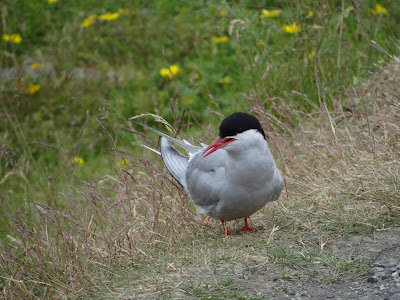Outside of Falcated Duck, there were a few other species of note. Arctic Tern was one we hadn't seen yet, Trumpeter Swan, Aleutian Tern, Pine Grosbeak, Red Crossbill, and Common Loon. eBird reports for some places in Alaska are VERY hard to come by, and they lack a lot of info. In hindsight I would have put a little more effort into today, but we were tired and really at our limits. There are tons of really good hikes right off the highway, but it's hard to gauge which ones are good for both the sights and the birds. Plus we were looking for strolls, not high elevation climbs.
But the eBird reports did give us a few stops. First stop was Tern Lake. As we drove we saw a flash of red cross the road. I really think it was a Pine Grosbeak. Like 95% sure. But since I'm not 100% I couldn't count it. Pine Grosbeak is a bird I've really wanted to get, but they're fairly hard to get. Part of it is they are so far north even in winter.
 |
| Common Merganser |
This is when I asked a question that I wished I never asked. I asked a local birder if Aleutian Terns had been seen. He said "no, but about an hour west of here in Soldotna I had them at Kenai NWR earlier this morning." I had to make a tough decision. We had an hour to spare, but that would be one less hour to look for Falcated Duck. I stuck to the plan and we continued north. I wish I had gone west.
 |
| Red-necked Grebe |
We arrived to a ton of birders, but no duck. We didn't see it, and it was pretty disappointing. But, like the Great Black Hawk in Portland last winter, the Falcated Duck was a gravy bird. It happened to be there, and we didn't make any plans centered around it. We would have stopped at Potter Marsh regardless, so I didn't get down about it. There were still a lot of great birds out, including an Arctic Tern that swooped down and showed off its popular aggression when you get too close to a hidden nest. We also got to compare Greater and Lesser Scaup, the Greater Scaup being a lifer, and Cackling vs. Canada Goose. I got a breeding plumage Red-necked Grebe and a lifer Rusty Blackbird as well. But the real highlight was a lifer Red-necked Phalarope. We had 2 fly-bys, allowing me to get another very unexpected lifer. We didn't have time to go to some ponds by the airport, but it was fine because we got Pacific Loon at Kenai Fjords.
 |
| Arctic Tern |
1. We got some amazing birds. The highlights were definitely Arctic Warbler, Kittlitz's Murrelet, Parakeet Auklet, and Pacific Loon.
2. Whatever you do, visit Denali. It is the crown jewel of our country. But it is not a great birding destination. There are no specialty birds and every bird can be found in more accessible places. But the mammals and scenery are the most stunning things you can see. Everyone should go at least once.
3. We missed some really good birds. Boreal Chickadee is a stunning miss that I thought would be easy, but we also missed Red Crossbill, Pine Grosbeak, Falcated Duck, Aleutian Tern, Red-throated Loon, and Thick-billed Murre. A lot of why we missed them because of number...
4. There is too much to do in Alaska. We ran ourselves ragged in a week, but we didn't go fishing or kayaking. As a result we also didn't have time to chase some of the birds we missed. An extra 2 days would have probably gotten us all of the Kenai Peninsula birds including Falcated Duck and we may have been able to snag a Northern Wheatear somewhere in Denali. We did so much, and we didn't even scratch the surface.
5. This was a life-changing trip. The beauty is astounding. The animals are near mythical. I came back with my mind refreshed and my stresses gone. I'm trying to figure out a lot of things in life at the moment and this was important for removing any stresses. That's what birding fever and untouched scenery will do for you. I now understand why people like Steve Jobs will go meditate in remote places. Anthony deserves a huge shoutout for being the perfect travel buddy and a very tolerant birding partner/photographer. It was actually depressing to get back to Houston because all I wanted to do was be back on that mountain looking down on the pristine land.
With 222 species down this year, where should I go next?
 |
| Cackling Geese look similar to Canada Geese but they have a shorter bill, head, and neck. They are also overall much smaller. |





No comments:
Post a Comment